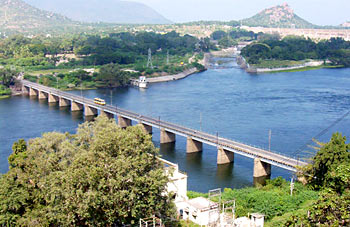The use of Kaveri River is primarily done for providing water for irrigation, water for household consumption and the generation of electricity. An estimate at the time of the first Five Year Plan puts the complete flow of the Kaveri at around 12 million acre-feet, of which 60% was used for land irrigation. The Torekadanahalli pump station sends 540 Mld (million liters per day) of water from Kaveri 100 km to Bangalore.
 Monsoon rains primarily supply the water for the Kaveri. Dams, such as the Krishna Raja Sagara Dam and Mettur Dam are built along the river. There are many dams on the tributaries too, such as the Banasura Sagar Dam project on a Kabini River tributary, stores water from monsoon periods and release the water during the dry months. Even during the months of February-May, the water levels are quite low, and in some channels and distributaries riverbeds become comparatively dry. Flow generally begins to amplify in June or July. In some years when rains are light, the low river point can be a reason of agricultural distress in areas that are dependent upon the Kaveri for irrigation.
Monsoon rains primarily supply the water for the Kaveri. Dams, such as the Krishna Raja Sagara Dam and Mettur Dam are built along the river. There are many dams on the tributaries too, such as the Banasura Sagar Dam project on a Kabini River tributary, stores water from monsoon periods and release the water during the dry months. Even during the months of February-May, the water levels are quite low, and in some channels and distributaries riverbeds become comparatively dry. Flow generally begins to amplify in June or July. In some years when rains are light, the low river point can be a reason of agricultural distress in areas that are dependent upon the Kaveri for irrigation.
The hydroelectric plant is built on the left Sivanasamudra Falls on the Kaveri in 1902 that was the first hydroelectric plant in Karnataka. The Krishna Raja Sagara Dam has a capacity of around 49 tmc ft and the Mettur Dam which creates Stanley Reservoir and has a power of 93.4 tmc ft.(thousand million cubic ft). In August 2003, the water inflow into reservoirs in Karnataka was at around 29 year low, with a 58% shortfall. Water stored in Krishna Raja Sagara dam was calculated to be only 4.6 tmc ft.















